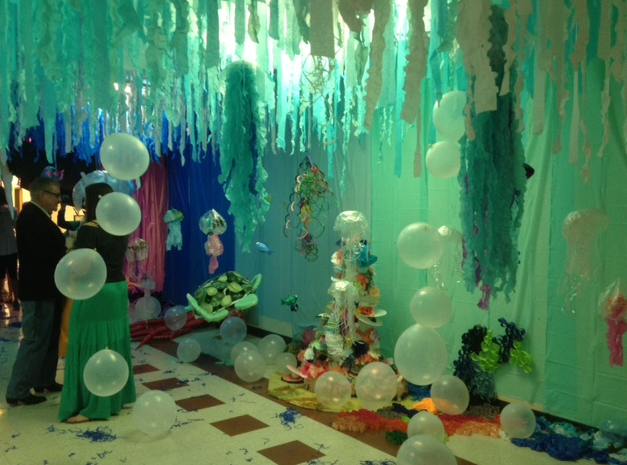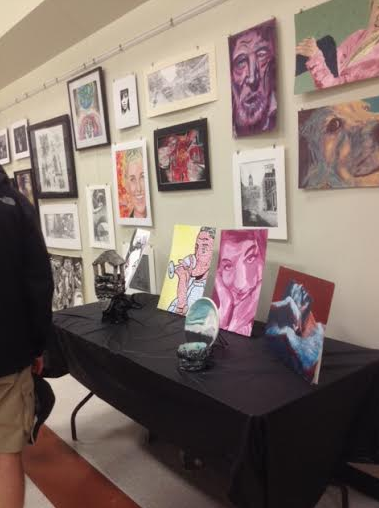
After weeks of work and hours of setup, the first annual art show, Depth, displayed a variety of student art pieces in addition to an installation piece created by the studio art classes Sunday, April 27.
With entries from intermediate and advanced students, this show aimed to exhibit mainly advanced level artwork, art teacher Abbey Trescott said. For those who entered pieces, this was an opportunity to show their work in a relaxed setting. Junior Rachel Choma, who entered five pieces in the show, found Depth less stressful than other shows she has entered because she knew her audience.
“I entered in a Columbia College show a few months ago and I was freaking out because it’s … it’s college people running the show and there’s going to be kids from all over the state entering in really cool pieces and I was worried that people might look at my piece and be like ‘Oh, that’s not good,’ compared to some other genius somewhere else,” Choma said. “I knew what kind of stuff was going to be in the show and the kind of artists who were behind [it], all of which all are fabulous people, I was more comfortable entering.”
The installation piece allowed those in Studio Art who did not or could not enter art in the show to participate as well, senior Staton Zaner, who is in AP Art 1 and 2, said. While Zaner entered five pieces into the art show, he also helped create pieces of the installation, which was mainly created by students in Studio Art classes, Trescott said.
Studio art students began by brainstorming ideas for the installation, which was difficult for the students, Trescott said. However, after this initial confusion, she said, students became more enthusiastic and excited about the parts they would make.
Junior Satey Yates said her favorite part of the show was making her piece of the installation because it allowed her to do group work, which she doesn’t normally do.
“It was a good change to create something with someone else,” Yates said. “It took us three weeks of in-class work. We used newspaper, paper mache and white acrylic paint for the support structure. We wrapped his limbs in lime green yarn then we painted odd roundish shapes with watercolor and acrylic green paint and hot glued theme to the turtle structure. We hot glued the limbs onto the top shell and hot glued a base to secure it underneath the entire thing.”

After students finished creating the pieces for the show, Trescott said the challenge was to install the display. Because this was the first installation at RBHS, it was difficult for the artists to envision how it would look, she said, and after they decided to add streamers to the ceiling they had to figure out how to put those up as well.
“The idea for the streamers on the ceiling were a bit of an afterthought. We weren’t sure how we were gonna actually hang the streamers until the Friday we started setting up, and then we decided to hot glue all of the streamers to the table cloths we used on the ceiling,” Trescott said. “What took the bulk of our time was hot gluing everything together and if we had the idea earlier, then we could have created them and then spent our time hanging instead of making during the installation process.”
In addition to understanding the processes of setting up the art show, this first annual art show provided Trescott experience for planning shows in the future. This year, the PTSA provided food, beverages and volunteers for the refreshments table. Also, the publishing company Ricoh printed the senior booklets at a discount. However, she said, they would like to seek out more sponsorship to help pay for the equipment they need.
“The bulk of our spending was on the picture rails and the hooks and the hardware for actually hanging the show that was probably our most expensive venture. Because we spent a lot of that this year, that will free up some of our budget for the future years so we won’t have to buy as much of the hardware stuff and we can use it for other things, like we could maybe have more food and refreshments,” Trescott said. “We would like some more picture rails because there are some spots in the hallways where we didn’t have the money to buy railing for the entire hallway and now that we know … in the future we can take advantage of more of the space in the hallway.”
In addition to hardware for hanging the entries, the installation added an additional cost to the show.
“The installation ended up costing a lot more money than we expected, which a lot of that came out of my pocket, which I’m OK with because I wanted it to be great,” Trescott said. “I wanted the kids to have a good experience, but fundraising for that in the future would be nice for my own pocket.”
Even with the high cost and unexpected challenges, Trescott believes this show was an amazing opportunity for students to show off their work because it opened up their work to a wider audience.
“We talk about how we’re in our little corner back here in the art wing and a lot of faculty members and students don’t get to see all the work we’re creating because we’re kind of tucked away,” Trescott said. “This really gave them the chance to be proud of their work and see it elevated to a new level because it’s so much different seeing it in a frame on the wall with other work and not just in the classroom on the board it’s just a much different environment.”
By Emily Franke













































































